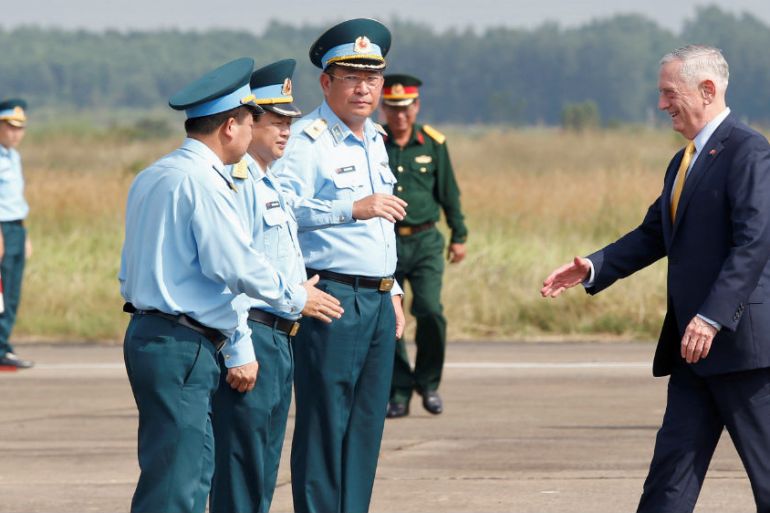Mattis tours contaminated Vietnam War-era Agent Orange site
Bien Hoa is one of Vietnam’s largest remaining dioxin hotspots with a US-funded clean-up due to start in 2019.

US defence chief James Mattis on Wednesday visited the former Bien Hoa storage depot for Agent Orange, a toxic defoliant widely used during the Vietnam War, ahead of a clean-up programme to start next year.
Bien Hoa, outside Ho Chi Minh City, is one of the largest remaining dioxin “hotspots” in the Southeast Asian nation. The US has pledged to clean up the site at a cost of some $390m and work is expected to start next year as part of a 10-year remediation effort led by development agency USAID.
Keep reading
list of 4 itemsThe Take: After Iran struck Israel, how did Jordan and Lebanon react?
The world cannot turn its back on Sudan and its neighbours any longer
Russia-Ukraine war: List of key events, day 784
US forces sprayed 80 million litres of the chemical over South Vietnam between 1962 and 1971 to try and deprive communist fighters of tree cover and food. Vietnam’s government says as many as three million Vietnamese were exposed to the dioxin, which is linked to severe birth defects, cancers and disabilities.
Some one million continue to suffer today, including at least 150,000 children.
|
|
Mattis said his visit to the site was aimed at making amends for some parts of the war.
“We had promised to help … so this is America keeping her promise to remediate some of the past,” Mattis, whose older brother served in Vietnam during the war, told reporters this week.
“I just want to get eyes on [the site] so when I go back and I talk to Congress, I can tell them my impression with actually having seen the site,” Mattis said ahead of the trip.
Spillage from the hasty clearing operation that took place in Bien Hoa at the end of the war is believed to have seeped beyond the base and into the groundwater, rivers and the local food chain.
An attempt by Vietnamese victims to secure compensation from the United States over Agent Orange has had little success. The US Supreme Court in 2009 declined to take up the case, while neither the US government nor the chemical manufacturers have ever admitted liability.
Mattis is on his second trip to Vietnam this year after visiting Hanoi in January.
In addition to Bien Hoa, the US and Vietnamese have identified two other “dioxin hotspots” at the airbases in Danang and Phu Cat. The project to clean up Danang has just been completed at a cost of $110m.